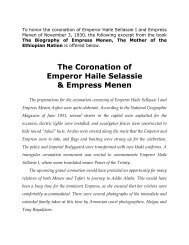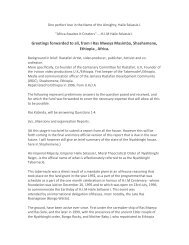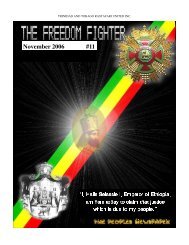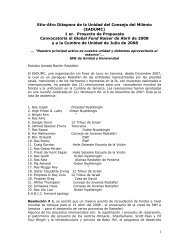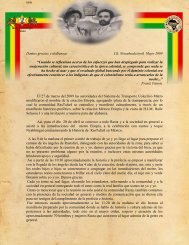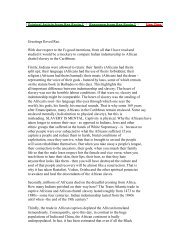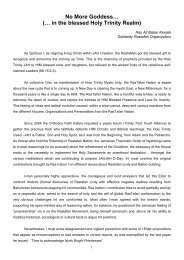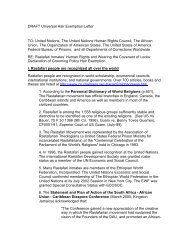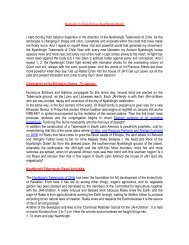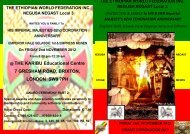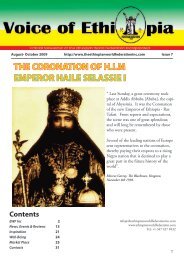You also want an ePaper? Increase the reach of your titles
YUMPU automatically turns print PDFs into web optimized ePapers that Google loves.
TRINIDAD AND TOBAGO RASTAFARI UNITED INC.<br />
<br />
<br />
Sadly, just as Rasta dominance over Jamaican consciousness<br />
was reaching heights, it would all quickly<br />
go down by the 1980 election in a hail of violent reactionary<br />
gang warfare, imported bullets and cocaine<br />
smoke, all due to worse than usual polytricks and poverty.<br />
Marley’s death in May of the following year<br />
blighted the music scene even more. Even though Jamaican<br />
music of the eighties seemed to turn away from<br />
spiritual themes and take on a colder, more gangster<br />
lean towards slackness, the Rasta image of reggae<br />
still remained firmly in place on the foreign market.<br />
Despite these declines during the post-Marley period,<br />
reggae would continue to affect music around the<br />
world, eventually taking its place as a Grammy category<br />
beside blues, rock, R&B, jazz, Latin and other<br />
mainstream genres as an established and respected<br />
form of music. Not until the early 1990s, after morphing<br />
from reggae to dancehall around 1985, would Jamaican<br />
music fully regain its strong worldwide popularity<br />
and position of influence. Newer sounds and<br />
different ambassadors have emerged: Sizzla, Capleton,<br />
Sean Paul, Shabba, Buju, Shaggy etc.<br />
Today, if the sales statistics are any indication, it's as if<br />
Bob never departed: his album "Legend" has held a<br />
permanent place on the Billboard Top 100 Albums<br />
chart since its release. Growing sales of his other records<br />
and Marley merchandise far outstrip Bob’s financial<br />
achievements during his own lifetime. And<br />
thanks to studio technology, Marley is still on the<br />
scene, singing duets with artists who weren’t even<br />
born yet when he passed on.<br />
We have seen some the reasons why it was and still is<br />
easy for those outside the Caribbean to mistake reggae<br />
and Rastafari as being identical. Questions remain:<br />
what is the fuller story on reggae music and what is<br />
Rasta music? How did Rasta faith and Jamaican<br />
music overlap as they evolved? What led to the high<br />
position of reggae music and Rasta thought in late<br />
seventies Jamaica? ? A great deal of mostly accurate<br />
material has been written on these subjects, so we will<br />
not attempt to do it all here. Next we’ll start to trace<br />
these cultural cross-currents in more detail.<br />
Greetings once again:<br />
This is the second in a<br />
regular series of articles<br />
about reggae music. Last<br />
time we dealt with dispelling<br />
certain myths surrounding<br />
reggae music and<br />
its connections to Rastafari.<br />
We highlighted the<br />
misconception (outside the<br />
Caribbean) that reggae music is pure Rasta music or entirely<br />
the product of Rastafari culture, and attempted to explain<br />
how this misconception came about.<br />
The history of Jamaican popular music’s development<br />
shows that, at every stage and from the beginning, Rasta<br />
culture has always made significant contributions, but that<br />
the music was developed by all sorts of people and cultural<br />
influences, both Jamaican and foreign, which had nothing<br />
to do with Rastafari. At the end of our last installment, we<br />
posed the question, among others, “what is the fuller story<br />
on reggae music and what is Rasta music?” Unfortunately,<br />
due to space limitations this month, we’ll only be able to<br />
scratch the surface of this topic, to be continued next<br />
month.<br />
To address these questions, it is first necessary to set the<br />
stage by exploring the nature of Caribbean culture in general.<br />
Caribbean culture is the result of different cultures,<br />
most of them imported (mostly by force) and not indigenous<br />
to the area, mixing together in a wildly complicated<br />
process of cross-fertilization. It can be thought of as a<br />
complex fabric and, like fabric, the result of multiple<br />
strands of cultural traditions cross-woven into a greater<br />
whole. In the same way, each Caribbean island tends to<br />
have its own distinctive culture which is also the result of<br />
different ethnic traditions weaving themselves together<br />
into a new hybrid fabric over time. This phenomenon occurs<br />
on multiple levels: language, race, music, cuisine, agricultural<br />
methods, architecture, etc.<br />
To address these questions, it is first necessary to set the<br />
stage by exploring the nature of Caribbean culture in general.<br />
Caribbean culture is the result of different cultures,<br />
most of them imported (mostly by force) and not indigenous<br />
to the area, mixing together in a wildly complicated<br />
process of<br />
<strong>August</strong> 2006 The Freedom Fighter. Pg 10



